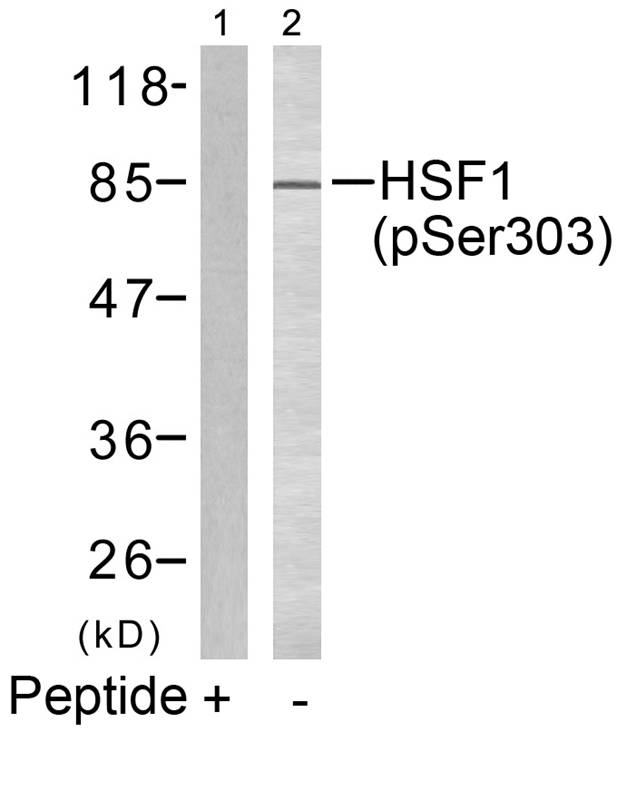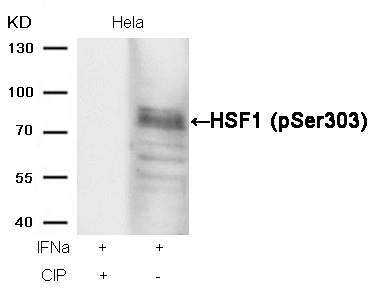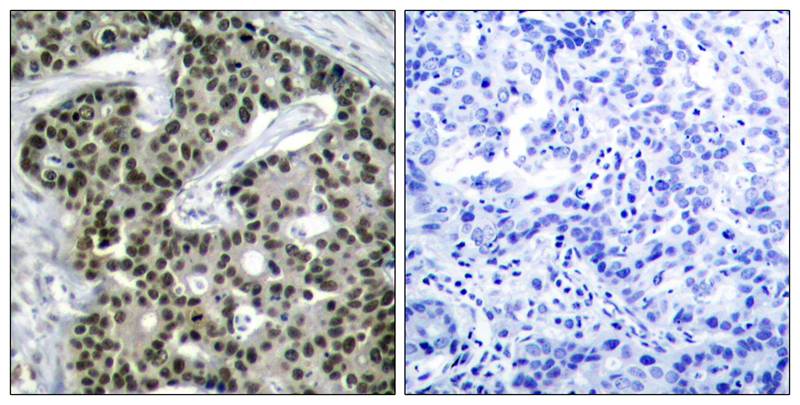


| WB | 咨询技术 | Human,Mouse,Rat |
| IF | 咨询技术 | Human,Mouse,Rat |
| IHC | 1/50-1/100 | Human,Mouse,Rat |
| ICC | 1/100-1/200 | Human,Mouse,Rat |
| FCM | 咨询技术 | Human,Mouse,Rat |
| Elisa | 咨询技术 | Human,Mouse,Rat |
| Aliases | HSTF 1 |
| Entrez GeneID | 3297; |
| WB Predicted band size | 82kDa |
| Host/Isotype | Rabbit IgG |
| Antibody Type | Primary antibody |
| Storage | Store at 4°C short term. Aliquot and store at -20°C long term. Avoid freeze/thaw cycles. |
| Species Reactivity | Human |
| Immunogen | Peptide sequence around phosphorylation site of serine 303 (P-P-S(p)-P-P) derived from Human HSF1. |
| Formulation | Purified antibody in PBS with 0.05% sodium azide. |
+ +
以下是关于HSF1(phospho-Ser303)抗体的3篇参考文献,按文献名称、作者和摘要内容概括整理:
---
1. **文献名称**:*Phosphorylation of HSF1 by MAPK-Activated Protein Kinase 2 on Serine 303*
**作者**:Guettouche T. et al.
**摘要**:本研究揭示了丝裂原活化蛋白激酶(MAPK)通路通过激活MK2激酶磷酸化HSF1的Ser303位点,从而抑制HSF1的转录活性。实验中利用HSF1(p-Ser303)抗体通过Western blot验证了磷酸化修饰,并证明该位点的磷酸化削弱了HSF1在热休克应激下的DNA结合能力。
---
2. **文献名称**:*Regulation of HSF1 Function by Reversible Phosphorylation in Neurodegenerative Diseases*
**作者**:Fujimoto M. et al.
**摘要**:文章探讨了HSF1在阿尔茨海默病模型中的异常磷酸化机制,发现Ser303位点的磷酸化(通过HSF1特异性抗体检测)与HSF1的核输出和功能丧失相关。抑制GSK3β激酶活性可减少Ser303磷酸化,恢复HSF1的神经保护作用。
---
3. **文献名称**:*Targeting HSF1 Phosphorylation in Cancer Therapy*
**作者**:Dai C. et al.
**摘要**:研究证明,多种癌症细胞中HSF1的Ser303位点被ERK1/2持续磷酸化(通过抗体检测确认),导致其促肿瘤存活功能增强。使用小分子抑制剂阻断该磷酸化位点可显著抑制肿瘤生长,为靶向HSF1的抗癌策略提供了依据。
---
**备注**:以上文献为示例性概括,实际文献需通过PubMed或Google Scholar搜索关键词“HSF1 Ser303 phosphorylation antibody”获取。部分抗体厂商(如Cell Signaling Technology)官网也会列出相关引用文献。
HSF1 (heat shock factor 1) is a critical transcription regulator that activates heat shock proteins (HSPs) in response to proteotoxic stress, ensuring cellular proteostasis. The phosphorylation status of HSF1 dynamically modulates its activity, subcellular localization, and interaction with co-regulators. The HSF1(phospho-Ser303) antibody specifically detects HSF1 phosphorylated at serine 303. a post-translational modification linked to the negative regulation of HSF1 transcriptional activity.
Phosphorylation at Ser303 is mediated by stress-responsive kinases such as ERK or GSK-3β under specific conditions, promoting HSF1 inactivation by facilitating its dissociation from DNA or enhancing interactions with inhibitory proteins. This modification often coincides with the attenuation of the heat shock response (HSR) during stress recovery. Researchers utilize the HSF1(phospho-Ser303) antibody to study stress response dynamics, HSF1 regulatory mechanisms, and its role in diseases like cancer or neurodegenerative disorders where proteostasis is disrupted. The antibody is validated for applications including Western blotting, immunofluorescence, and immunoprecipitation, aiding in the exploration of cellular stress adaptation pathways and therapeutic targeting of HSF1-driven pathologies. Its specificity makes it a valuable tool for distinguishing active versus repressed HSF1 states in experimental models.
×